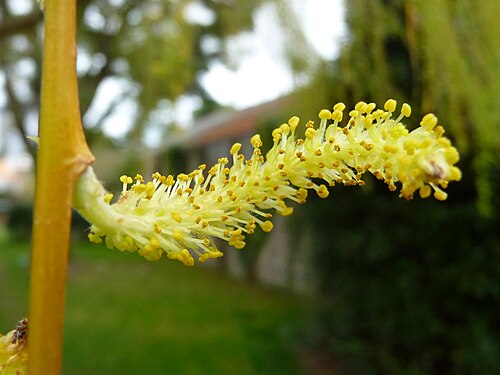Peking Willow
| Habit | tree
| |
|---|---|---|
| Height: | ⇕ | 40 ft"ft" can not be assigned to a declared number type with value 40. |
| Width: | ⇔ | 35 ft"ft" can not be assigned to a declared number type with value 35. |
| Lifespan: | ⌛ | perennial |
| Origin: | ✈ | China |
| Exposure: | ☼ | sun |
|---|---|---|
| Water: | ◍ | wet, moist |
| Features: | ✓ | deciduous |
| USDA Zones: | 5 to 10 | |
| Sunset Zones: | 3-24, 26n, 28, 30-34, 39 |
|
Salix > |
L. > |
Salix babylonica (Babylon Willow (var. babylonica) or Peking Willow (var. matsudana); is a species of willow native to dry areas of northern China, but cultivated for millennia elsewhere in Asia, being traded along the silk road to southwest Asia and Europe.[1][2]
It is a large-sized to medium deciduous tree, growing up to 20-25 m tall. It grows rapidly, but has a short lifespan. The shoots are yellowish-brown, with small buds. The leaves are spirally arranged, narrow, light green, 4-16 cm long and 0.5-2 cm broad, with finely serrate margins and long acuminate tips ; they turn a gold-yellow in autumn. The flowers are arranged in catkins produced early in the spring; it is dioecious, with the male and female catkins on separate trees.[1][3]
Read about Peking Willow in the Standard Cyclopedia of Horticulture
|
|---|
|
Salix babylonica. (syn. S. pendula). Napoleon's Willow. A tree of weeping habit, 30-40 ft. high, with long slender olive-green or purplish branches: buds small, acute: lvs. 2-6 in. long, attenuate at base and apex: aments appearing with the lvs., slender, the pistillate green, 1 in. long, caps. small. China.—Long known in cult. and often grown in cemeteries. Tender N. Var. annularis, Forbes, lvs. twisted back so as to form a sort of ring.
|
Cultivation
Propagation
Pests and diseases
It has also been introduced into many other areas, but has not generally been successfully cultivated outside China, being very short-lived and unsightly due to canker diseases in the more humid climates in much of Europe and North America. It is particularly susceptible to canker disease, Willow Anthracnose (Marssonina salicicola) and sensitive to late-spring frosts.[4][5]
Varieties
of var. babylonica (Babylon Willow).
- 'Babylon' (synonym: 'Napoleon') The most widely grown cultivar with its typical weeping branches[6]
- 'Crispa' (synonym: 'Annularis') A mutant of 'Babylon' with spirally curled leaves
of var. matsudana (Pekin Willow).
- 'Pendula' One of the best weeping trees, with a silvery shine, hardier and more disease resistant.
- 'Tortuosa' Upright tree with twisted and contorted branches.
Early Chinese cultivar selections include the original Weeping Willow Salix babylonica 'Pendula', in which the branches and twigs are strongly pendulous. However, most Weeping Willows outside China are hybrids between this cultivar, and either White Willow Salix alba (Salix Sepulcralis Group) or Crack Willow Salix fragilis (Salix × pendulina Wenderoth), which are better adapted to the more humid climates of most heavily populated regions of Europe and North America. The most widely grown Weeping Willow cultivar is Salix Sepulcralis Group 'Chrysocoma', with bright yellowish shoots.[4][5]
Gallery
References
- ↑ 1.0 1.1 Flora of China: Salix babylonica
- ↑ Germplasm Resources Information Network: Salix babylonica
- ↑ Huxley, A., ed. (1992). New RHS Dictionary of Gardening. Macmillan ISBN 0-333-47494-5.
- ↑ 4.0 4.1 Cite error: Invalid
<ref>tag; no text was provided for refs namedbean4 - ↑ 5.0 5.1 Meikle, R. D. (1984). Willows and Poplars of Great Britain and Ireland. BSBI Handbook No. 4. ISBN 0-901158-07-0.
- ↑ Santamour, F.S. & McArdle, A.J. (1988). Cultivars of Salix babylonica and other Weeping Willows. Journal of Arboriculture 14: 180-184
- Standard Cyclopedia of Horticulture, by L. H. Bailey, MacMillan Co., 1963
External links
- w:Peking Willow. Some of the material on this page may be from Wikipedia, under the Creative Commons license.
- Peking Willow QR Code (Size 50, 100, 200, 500)




